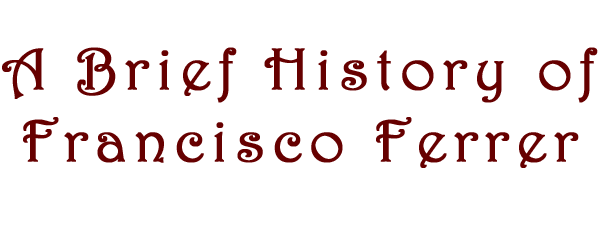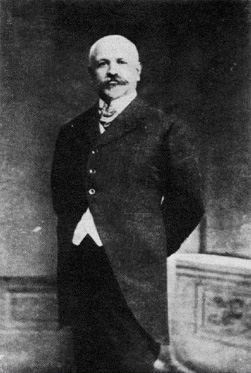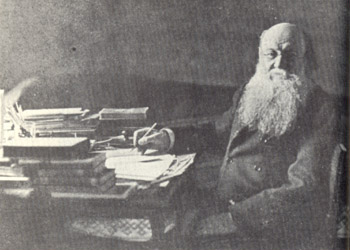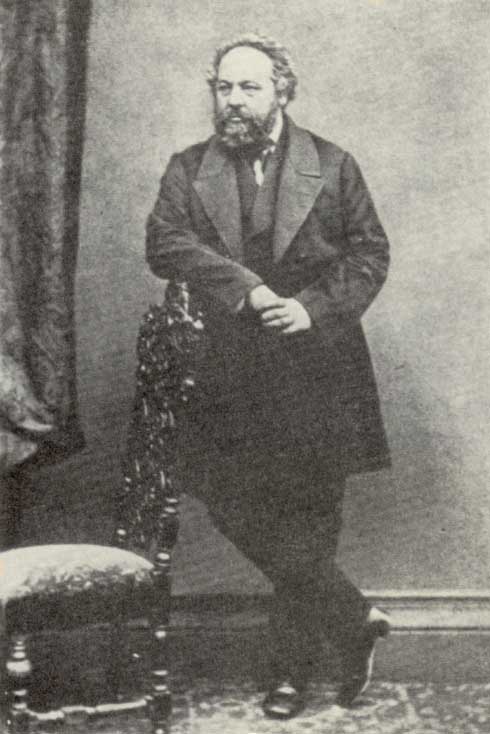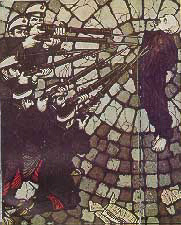 |
Inside
|
|
|
|
|
|
|
|
|
|
|
|
|
|
|
|
|
|
|
|
|
|
|
![]()
Links to Related Sites:
The Pitzer College Anarchy Archives
The Francisco Ferrer Collection - Mandeville Special Collections Library at the University of California, San Diego
The Stelton Modern School Archive at Rutger's University
Modern School Texts from:
![]()
Other
The University at Albany History Department
 |
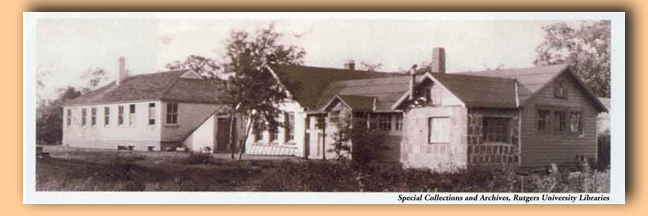 |
The story of Francesco Ferrer�s involvement with the Rational Education Movement in Spain is complicated and often contradictory, if relatively short. While the theoretical foundations for "rational" education had been laid out as early as the 1860s by Mikhail Bakunan, Paul Robins, Fredrick Froebel, Peter Kropotkin, Tolstoy; and even earlier by no less than Rousseau; Ferrer�s own involvement did not begin until after 1895, and did so as a result of his involvement with anarchist revolutionary movements in Europe. Ferrer came to revolutionary politics at a pivotal time in Spanish History, when the prevailing political climate was more friendly to leftist thought, and so was able to rise to prominence. It is somewhat ironic that a man who would come to be so reviled among his peers in Spain would come to be one of the movement's great martyrs. Ferrer can be a difficult person to grasp, and while he is often canonized by the proponents of free education, many of his actions call to question his commitment to those ideals. While a steadfast opponent of the establishment, Ferrer was in fact quite wealthy. While he spoke and wrote about the ideals of Free Education, his own interest seemed more directed toward the training of future revolutionaries. James Joll has called Ferrer an �intellectual practitioner of free love,�[1] which is, perhaps, a bit harsh, but Ferrer�s personal life was colourful to say the least and adds to the question as to whether he may have, in the later part of his life, used revolutionary politics and education not as its own end, but to further his own personal celebrity and gain. Francisco Ferrer had been a revolutionary all of his life. He was born on a farm near Barcelona in 1859, a time when Spanish society had been going through great upheaval. In 1868, Ferrer, only 9 years old, witnessed revolution with the abdication of Queen Isabella in favour of more liberal, republican government. The struggle for a viable successor would provide the context for the Franco-Prussian War. This would lead to a weak and ineffectual constitutional monarchy, followed by a short lived republic which led to a period of near civil war and general social upheaval before the eventual restoration of the Bourbon Throne. This period of sporadic uprisings from both the right and left wings could not help but leave its mark on Ferrer. Prior to becoming an anarchist and educator, he had been involved with the anticlerical Republican movement against the Spanish monarchy, and was a follower of Manuel Ru�z Zorilla. After making an aborted attempt on the life of General Villacampe in Madrid in 1886 he was exiled to Paris. There, in the caf�s and bistros, Labour Temples and Lodges, he learned and refined his own anarchist and revolutionary leanings. He became involved in many liberal causes, becoming a supporter of Dreyfus in the famous French Anti-Semitism case and serving as a delegate to the 1896 Congress of the Second International. He returned to Madrid in the 1901 after inheriting 1,300,000 Francs from an elderly spinster of his acquaintance, Mlle. Ernestine Meuni�.
The ideals of free education begin in response to the ideals of classical education that were particularly prevalent at that time. The first part of the free education system begins with the belief that imitation and repetition perverted or inhibited the natural development of the pupil. The learning of new skills, both simple and complex should instead be done in a natural fashion. In contrast to the development of ivory tower scholarship, the proponents of rational education believed in knowledge derived from both experience of, and interaction with the world - "learning by doing." This was set in the educational needs of the working class, many of whom needed training in skilled trades, as well as the ability to read and write, at a time when illiteracy rates in Spain could be as high as 73 percent![4]
It was also felt that schools, in addition to intellectual development, should be responsible for the physical and, like their adversaries in the parochial schools, moral development of the child. Games, sports, nature walks and gymnastics were all part of a program designed to develop simultaneously the mind, body and spirit. This also served to teach the child early on the interconnectedness of things and prevent disconnection or the development of an �artificial dualism� � between mind and body, man and nature, between men and women. Towards this end coeducation � a new and often scandalous concept � was also encouraged. School was designed to resemble life. Thus, the critique of the parochial system was also extended to include the inequities of the state system. Ferrer wrote, by way of comparison: In French lay schools, �the State (was) replaced (by) God, Christian virtue by Civic Duty, religion by patriotism; and submission and obedience to the king, the Aristocrat, and the clergy, by reverence for the bureaucrat, the proprietor and the employer.�[5] Implicit in this was a critique not only of religious and state education, but a critique of the capitalist system as well. For anarchists, the mission of rational education was to destroy prejudice and encourage the development of a �scientific-psychological mentality.�[6] Ferrer was looking for a revolution, and the only way this revolution could succeed, or even get off the ground, was through education of the masses and a breaking of the Marxist idea of False Consciousness. However, by 1900 a decade of terrorism and repression had taken the revolutionary steam out of many in the anarchist movement. Ferrer seemed to see hope for the future through the training of a new generation of anarchists and revolutionaries, and he saw in the principals of free education his route to this goal. He saw the modern schools as a way to �combat religion, false concepts of property, nationalism and family.�[7] On September 8, 1901, with funds from his personal fortune, Ferrer established the Escuela Moderna in Barcelona. From the start, Ferrer downplayed his anarchist connections, emphasizing instead the progressive and anticlerical aspects of his programme. This gained him some support among the middle classes (the �Scientific Masses�) to whom his appeals were mostly directed. It also deflected attention from his presence in Barcelona. None-the-less, Ferrer worked closely with Anarchist organizations in the development and running of the school. However, while Ferrer publicly emphasized the principals of Rational Education, his private views were somewhat different. The Rational Education offered by Ferrer�s Escuela Moderna included a great deal of indoctrination into the principles of anarchism and revolution. While the school was certainly more progressive than any available alternative, ultimately most of the schools educational offerings came back to the revolutionary. Ironically, the �Scientific Masses� that Ferrer so championed were effectively excluded by the school�s high tuition (15 pesetas a month[8]). Moreover, the working class desired more practical educational goals than those Ferrer would come to offer. Ferrer's apparent disregard for his own stated policies would quickly drive out Clementine Jacquinat, the school�s first director, who broke with Ferrer in 1903 and denounced him publicly in a privately published pamphlet distributed in Barcelona. None-the-less, through active self promotion and a dynamic and engaging personality, Ferrer remained the champion of popular as well as radical education in Barcelona as well as Spain at large, and he rapidly rose to some celebrity. Because existing textbooks were considered inappropriate for the Escuela Moderna, Ferrer used some of his fortune to build a publishing house to develop special textbooks for the school. In addition, he produced some revolutionary pamphlets and manifestos as well as introductory texts to the natural and social sciences. Because of the low cost of Ferrer�s publications, they were adapted by many of the other lay schools in the area. One example, a textbook history of Christianity El Origen del Christianismo was highly anti-clerical, concluding with a homage to "Science," �the liberator of humanity.�[9] Both the Escuela Moderna and Ferrer�s activities expanded rapidly during the period from 1901 to 1906. By then, he had opened additional schools around Barcelona, which served a total of about 125 students. The highpoint came on Good Friday � April 12, 1906, when 1,700 children from anarchist and lay schools all over Barcelona assembled at Tibidado for a secular commemorative. That celebration would come to be the pinicle for free education in Spain. Only a few short months after the Good Friday demonstration, all would begin a rapid decline. In September of 1806, during King Alfonso XIII�s marriage celebration, Mateo Moral, an employee of Ferrer�s printing house threw a bomb at the wedding procession. Shortly thereafter, Moral committed suicide. Ferrer was arrested as the instigator of the incident and, using a provision of the 1902 Inspection Law, all the anarchist schools in Barcelona were closed. Newspapers and magazines across Spain denounced the assassination attempt. El Coraz�n de Jesus, a local paper run by the clergy wrote �these crimes will continue as long as Spaniards maintain the freedom to read, to teach and to think, from which comes all these antisocial monsters.�[10] Steadfastly denying any involvement, he actively encouraged an international campaign for his release, using clerical and conservative attacks against him as proof of his persecution. However, Ferrer�s trial by public tribunal was a shambles, and while he seems, in fact, to have been guilty of putting Moral to the task, little evidence directly implicating him was brought. Moreover, the liberal government of the Marques de la Vega de Arnije was committed to the ideals of secular education and defended it against both real and perceived attacks from the clerical establishment. The tribunal eventually caved in to external pressure from Ferrer�s campaigning and he was ultimately acquitted on 12 June, 1907.[11] Following his release, Ferrer embarked on a speaking tour of Europe. There, he was able to promote himself as the defender of rational secular education against the attacks of both conservatives and the clergy. While his reputation in Spain had been sorely damaged, he became a champion martyr and cause celebre among the leftist intellectual community in Europe, even as he became increasingly irrelevant at home. The Free Education Movement had lost momentum after the 1906 bombing, and Ferrer, who spent increasing amounts of time abroad, gradually lost control of it. Furthermore, many of Ferrer�s associates began to loose their positions, the Radical Republicans shifted to more moderate views and tactics and formally broke ties with him. Many lay schools stopped using his texts. Abroad, Ferrer was increasingly becoming the spokesman of rational, non-clerical education, but at home he suffered from a backlash against his movement. The branch schools he had opened suffered faltering enrollment, and the main school in Barcelona remained closed. The Tragic Week of July, 1909 was the final blow for Ferrer�s modern school. The Tragic week began as a protest against the Moroccan War, but it rapidly disintegrated into general rioting. In the course of the riots, 80 religious foundations were destroyed or burned, and the government was forced to declare martial law and use the military to restore order. A new conservative party that had come to prominence in the government in 1907 had Ferrer arrested and tried by Military Tribunal. He was convicted as the �author and chief� of the events of the Tragic Week, and was executed by firing squad at the Fortress of Monjuich on October 13th, 1909.
This was due in no small part to the fact that Ferrer had managed to alienate many in the leftist community in Barcelona. He had become arrogant and was perceived by many as intellectually dishonest. As his methods and agenda became known, he had lost much of the Middle Class support that he had so coveted. Carolyn Boyd has observed that, for the socialist and anarchist organizations still active in Spain, Ferrer was in fact of more use dead than alive. Dead, he could be exploited as a martyr.[12] Furthermore, secular education in Spain had become linked in the public imagination with revolution, rebellion and leftist indoctrination. Conservatives and the clergy could and did, argue with example that education in the hands of the masses was dangerous. Future proposals for secular public education were defeated when the spectre of social revolution was raised by the right wing. Only abroad, where he was known only through his published writing and speeches did he remain a champion of Free Education.
In light of his revolutionary activities, Francisco Ferrer is a questionable martyr. His dynamic and engaging personality is undoubtable, his commitment to the principals of free education may be questionable, but regardless of these personal failings, the mark that he ultimately put on the Free Education Movement has been profound. [1] Joll, James. The Anarchists. Eyre & Spottiswoode. London, England. 1979. pg. 215. [2] Boyd, Carolyn P. The Anarchists and Education in Spain, 1868-1909. The Journal of Modern History Vol. 48, Issue 4, On Demand Supplement. December, 1976, pg. 125-170. [3] ibid. pg. 148 [4] ibid. pg 134. 1877 figure. By 1910 it had shrunk to a still outrageous 59%. [5] Francisco Ferrer La Escuela Moderna pg. 77. [6] ibid. Princiipios de moral cient�fico. Unpublished manuscript. Quoted in Boyd, pg. 147. [7] ibid. [8] Boyd, pg. 151 [9] Malvert, El Origen del Christianismo (Barcelona, 1902). Quoted in Boyd, pg. 154. [10] Martyr des pr�tres, pg. 24. Quoted in Boyd, Pg 155 [11] The case against Ferrer is a complicated one, and while substantial evidence exists suggesting that he was the mastermind behind the bombings, other sources have reasonably called that evidence to question. [12] Boyd � pg. 158. |
||||||||||||||
|
|
||||||||||||||
